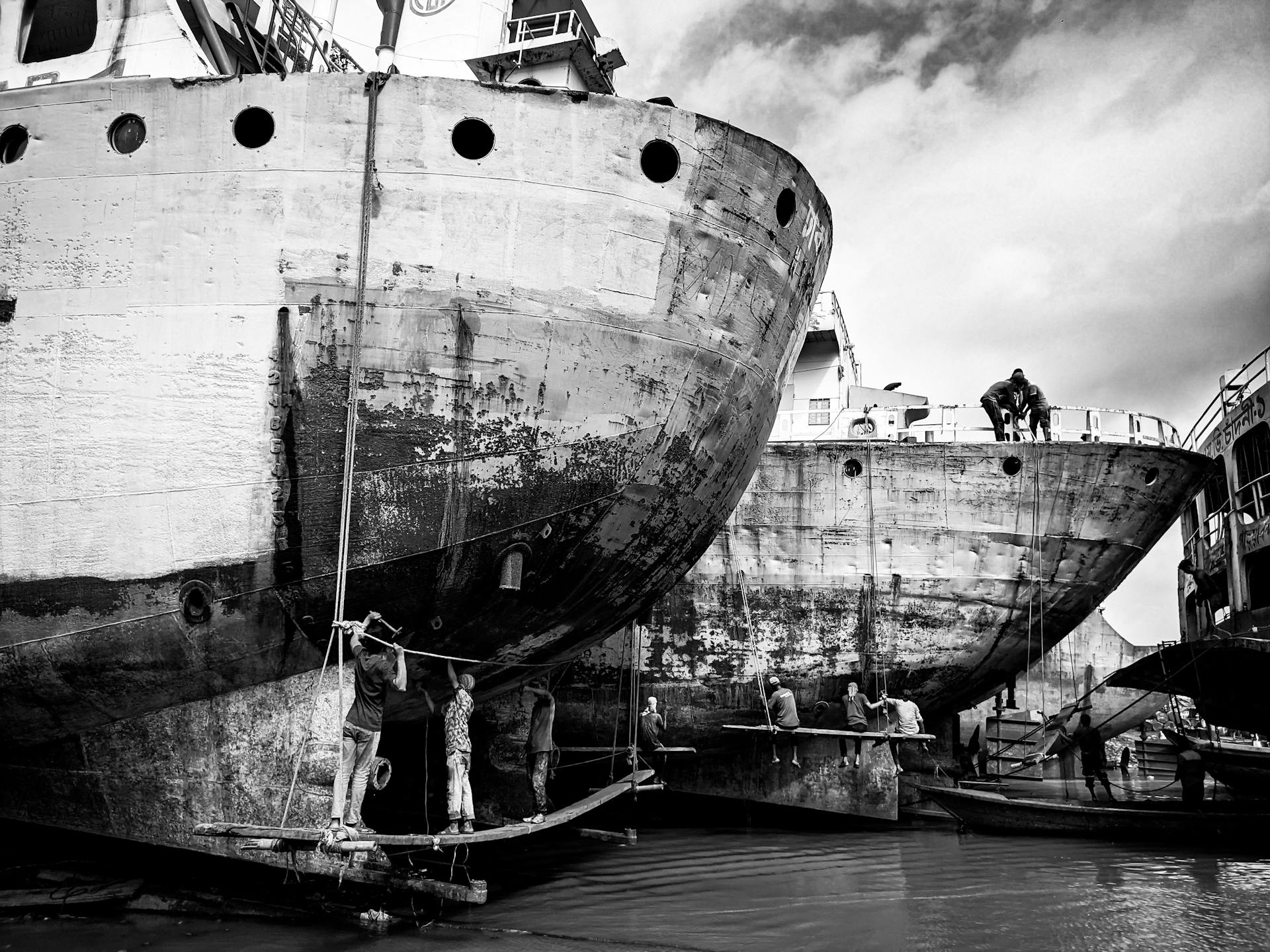
The Marine Hospital Service was established in 1798 to provide medical care to merchant sailors and other mariners. It was a significant development in the history of healthcare.
The service was initially funded by a tax on merchant vessels, with the goal of improving the health and well-being of those who worked at sea. This was a major step forward in recognizing the importance of healthcare for those in the maritime industry.
The Marine Hospital Service was responsible for establishing hospitals and providing medical care to sailors and mariners in need.
History of Marine Hospital Service
The Marine Hospital Service has a rich history that dates back to 1798, when the 5th Congress of the United States passed "An Act for the Relief of Sick and Disabled Seamen." This act created Marine Hospitals to care for sick seamen and was the first federal health law.
The Marine Hospital Fund was placed under the Revenue Marine Service, a forerunner of the present-day Coast Guard, within the Department of the Treasury. A tax was authorized, deducting twenty cents per month from the wages of seamen to raise funds for physicians and hospitals.
Additional reading: Postal Services Act 2000

Boston was the site of the first Marine Hospital facility, followed by others in major port cities along the East Coast. As the United States expanded, Marine Hospitals were built along inland waterways, the Great Lakes, and the Gulf of Mexico.
In 1869, Dr. John Shaw Billings investigated the Marine Hospital Fund and found it to be inadequate and disorganized. This led to a reorganization of the service.
In 1870, the Marine Hospital Service was formally established as a centrally controlled organization within the Department of the Treasury. Dr. John Maynard Woodworth was appointed Supervising Surgeon and transformed the service into a disciplined organization.
Dr. Woodworth created a mobile work force of physicians who could be assigned as needed to Marine Hospitals. He also created the Marine Hospital Service fouled anchor and caduceus seal, which is still used today by the Public Health Service.
The Commissioned Officer Corps was established in 1889, initially open only to physicians. Over time, the Corps expanded to include other health professionals.
Today, the records of the Marine Hospital Service are stored at the National Library of Medicine and the National Archives.
For your interest: National Drayage Services
Evolution and Expansion
The Marine Hospital Service started to take on more responsibilities in the late 19th century, expanding its scope beyond caring for merchant seamen. It began to control infectious disease, a role that was previously handled by individual states.
Quarantine authority was initially shared between the Marine Hospital Service, the U.S. Army, and the U.S. Navy, but it eventually reverted solely to the Marine Hospital Service in 1883. This marked a significant shift in the Service's role.
The Marine Hospital Service started to take over quarantine functions from individual state authorities over the next half a century. This was a major undertaking, as it involved coordinating with multiple states and ensuring that public health was protected.
In 1891, the Federal Government took over the processing of immigrants from individual states, and the Marine Hospital Service was assigned the responsibility for the medical inspection of arriving immigrants. This was a critical role, as it helped to prevent the spread of disease.

The Marine Hospital Service's duties continued to expand, and it began to include domestic and foreign quarantine, as well as other national public health functions. The Service's hospitals also started to include research and prevention work, in addition to patient care.
The Service's internal divisions were formed in 1899, including the Division of Marine Hospitals and Relief, the Division of Domestic Quarantine, and the Division of Foreign Quarantine and Immigration. These divisions would eventually give rise to other organizations, including the Centers for Disease Control and Prevention (CDC) and the National Institutes of Health.
Here are some of the key divisions and their descendants:
- The Division of Domestic Quarantine became the Division of States Relations and then the Bureau of State Services in 1943.
- The Division of Scientific Research became the National Institutes of Health.
- The Division of Foreign Quarantine eventually became the CDC Division of Global Migration and Quarantine.
- The Division of Sanitary Reports and Statistics was an ancestor of the CDC National Center for Health Statistics.
The Marine Hospital Service continued to evolve and expand, with a major name change in 1902 to the "Public Health and Marine-Hospital Service." This change reflected the Service's growing focus on public health, rather than just caring for sailors.
Uniform and Identity
The U.S. Public Health Service uniform is a distinctive and impressive sight, as seen in the ceremonial uniform worn by Dr. Mountin. It's based on a naval uniform, but with the USPHS seal prominently displayed.

The seal demonstrates that the U.S. Public Health Service is a branch of the United States uniformed services, alongside the Navy, Army, Coast Guard, Marines, Air Force, Space Force, and NOAA.
The uniform is made up of a long-sleeved, blue wool coat, a white and blue hat, leather belt, and ceremonial sword. It's a symbol of the service's commitment to protecting public health.
Here are some key facts about the U.S. Public Health Service uniform and identity:
- The U.S. Public Health Service uniform is decorated with the USPHS seal, which demonstrates the service's status as a branch of the United States uniformed services.
- The uniform is based on a naval uniform, but with distinctive USPHS elements.
- The ceremonial uniform worn by Dr. Mountin includes a long-sleeved, blue wool coat, a white and blue hat, leather belt, and ceremonial sword.
Health Services
The Marine Hospital Service provided health services to sailors and other seafarers.
This was especially important for those serving on ships that traveled to tropical regions, where diseases like yellow fever and malaria were prevalent.
The service had a network of hospitals and dispensaries located at major ports, making medical care accessible to those who needed it.
These facilities offered a range of services, including treatment for illnesses and injuries, as well as preventative care like vaccinations.
The Marine Hospital Service also conducted research on the causes and treatment of diseases affecting seafarers, which helped improve medical care for everyone.
Featured Images: pexels.com


